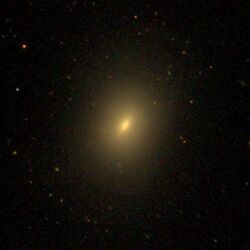Astronomy:NGC 227
From HandWiki
Short description: Galaxy in the constellation Cetus
| NGC 227 | |
|---|---|
 SDSS image of NGC 227 | |
| Observation data (J2000 epoch) | |
| Constellation | Cetus |
| Right ascension | 00h 42m 36.8s[1] |
| Declination | −01° 31′ 44″[1] |
| Redshift | 0.017669[1] |
| Distance | 237 Mly[2] |
| Apparent magnitude (V) | 13.11[1] |
| Characteristics | |
| Type | S0[1] |
| Apparent size (V) | 1.6' × 1.3'[1] |
| Other designations | |
| UGC 456, CGCG 383-076, MCG +00-02-135, 2MASX J00423684-0131436, 2MASXi J0042365-013137, 6dF J0042367-013144, PGC 2547.[1] | |
NGC 227 is a lenticular galaxy located approximately 237 million light-years from the Sun[2] in the constellation Cetus. It was discovered on October 1, 1785 by William Herschel.[3]
See also
References
- ↑ 1.0 1.1 1.2 1.3 1.4 1.5 1.6 "NASA/IPAC Extragalactic Database". Results for NGC 0227. http://ned.ipac.caltech.edu/cgi-bin/objsearch?objname=NGC+227&extend=no&hconst=73&omegam=0.27&omegav=0.73&corr_z=1&out_csys=Equatorial&out_equinox=J2000.0&obj_sort=RA+or+Longitude&of=pre_text&zv_breaker=30000.0&list_limit=5&img_stamp=YES.
- ↑ 2.0 2.1 An object's distance from Earth can be determined using Hubble's law: v=Ho is Hubble's constant (70±5 (km/s)/Mpc). The relative uncertainty Δd/d divided by the distance is equal to the sum of the relative uncertainties of the velocity and v=Ho
- ↑ "New General Catalog Objects: NGC 200 - 249". Cseligman. http://cseligman.com/text/atlas/ngc2.htm#227.
External links
- NGC 227 on WikiSky: DSS2, SDSS, GALEX, IRAS, Hydrogen α, X-Ray, Astrophoto, Sky Map, Articles and images
- SEDS
Coordinates: ![]() 00h 42m 36.8s, -01° 31′ 44″
00h 42m 36.8s, -01° 31′ 44″
 |

